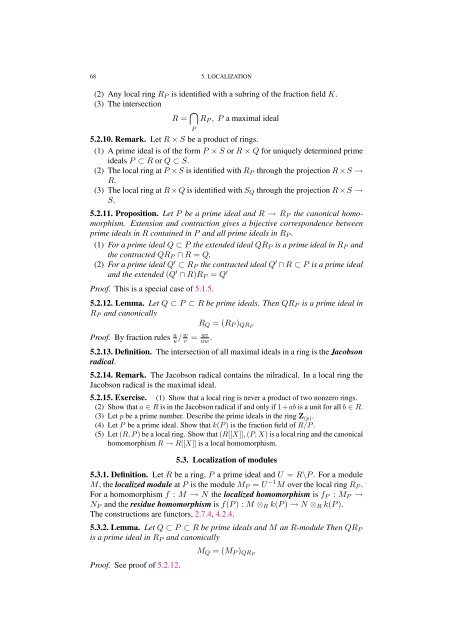Commutative algebra - Department of Mathematical Sciences - old ...
Commutative algebra - Department of Mathematical Sciences - old ...
Commutative algebra - Department of Mathematical Sciences - old ...
You also want an ePaper? Increase the reach of your titles
YUMPU automatically turns print PDFs into web optimized ePapers that Google loves.
68 5. LOCALIZATION<br />
(2) Any local ring RP is identified with a subring <strong>of</strong> the fraction field K.<br />
(3) The intersection<br />
R = <br />
RP , P a maximal ideal<br />
P<br />
5.2.10. Remark. Let R × S be a product <strong>of</strong> rings.<br />
(1) A prime ideal is <strong>of</strong> the form P × S or R × Q for uniquely determined prime<br />
ideals P ⊂ R or Q ⊂ S.<br />
(2) The local ring at P ×S is identified with RP through the projection R ×S →<br />
R.<br />
(3) The local ring at R × Q is identified with SQ through the projection R × S →<br />
S.<br />
5.2.11. Proposition. Let P be a prime ideal and R → RP the canonical homomorphism.<br />
Extension and contraction gives a bijective correspondence between<br />
prime ideals in R contained in P and all prime ideals in RP .<br />
(1) For a prime ideal Q ⊂ P the extended ideal QRP is a prime ideal in RP and<br />
the contracted QRP ∩ R = Q.<br />
(2) For a prime ideal Q ′ ⊂ RP the contracted ideal Q ′ ∩ R ⊂ P is a prime ideal<br />
and the extended (Q ′ ∩ R)RP = Q ′<br />
Pro<strong>of</strong>. This is a special case <strong>of</strong> 5.1.5.<br />
5.2.12. Lemma. Let Q ⊂ P ⊂ R be prime ideals. Then QRP is a prime ideal in<br />
RP and canonically<br />
Pro<strong>of</strong>. By fraction rules a w av<br />
u / v = uw .<br />
RQ = (RP )QRP<br />
5.2.13. Definition. The intersection <strong>of</strong> all maximal ideals in a ring is the Jacobson<br />
radical.<br />
5.2.14. Remark. The Jacobson radical contains the nilradical. In a local ring the<br />
Jacobson radical is the maximal ideal.<br />
5.2.15. Exercise. (1) Show that a local ring is never a product <strong>of</strong> two nonzero rings.<br />
(2) Show that a ∈ R is in the Jacobson radical if and only if 1+ab is a unit for all b ∈ R.<br />
(3) Let p be a prime number. Describe the prime ideals in the ring Z (p).<br />
(4) Let P be a prime ideal. Show that k(P ) is the fraction field <strong>of</strong> R/P .<br />
(5) Let (R, P ) be a local ring. Show that (R[[X]], (P, X) is a local ring and the canonical<br />
homomorphism R → R[[X]] is a local homomorphism.<br />
5.3. Localization <strong>of</strong> modules<br />
5.3.1. Definition. Let R be a ring, P a prime ideal and U = R\P . For a module<br />
M, the localized module at P is the module MP = U −1 M over the local ring RP .<br />
For a homomorphism f : M → N the localized homomorphism is fP : MP →<br />
NP and the residue homomorphism is f(P ) : M ⊗R k(P ) → N ⊗R k(P ).<br />
The constructions are functors, 2.7.4, 4.2.4.<br />
5.3.2. Lemma. Let Q ⊂ P ⊂ R be prime ideals and M an R-module Then QRP<br />
is a prime ideal in RP and canonically<br />
Pro<strong>of</strong>. See pro<strong>of</strong> <strong>of</strong> 5.2.12.<br />
MQ = (MP )QRP
















